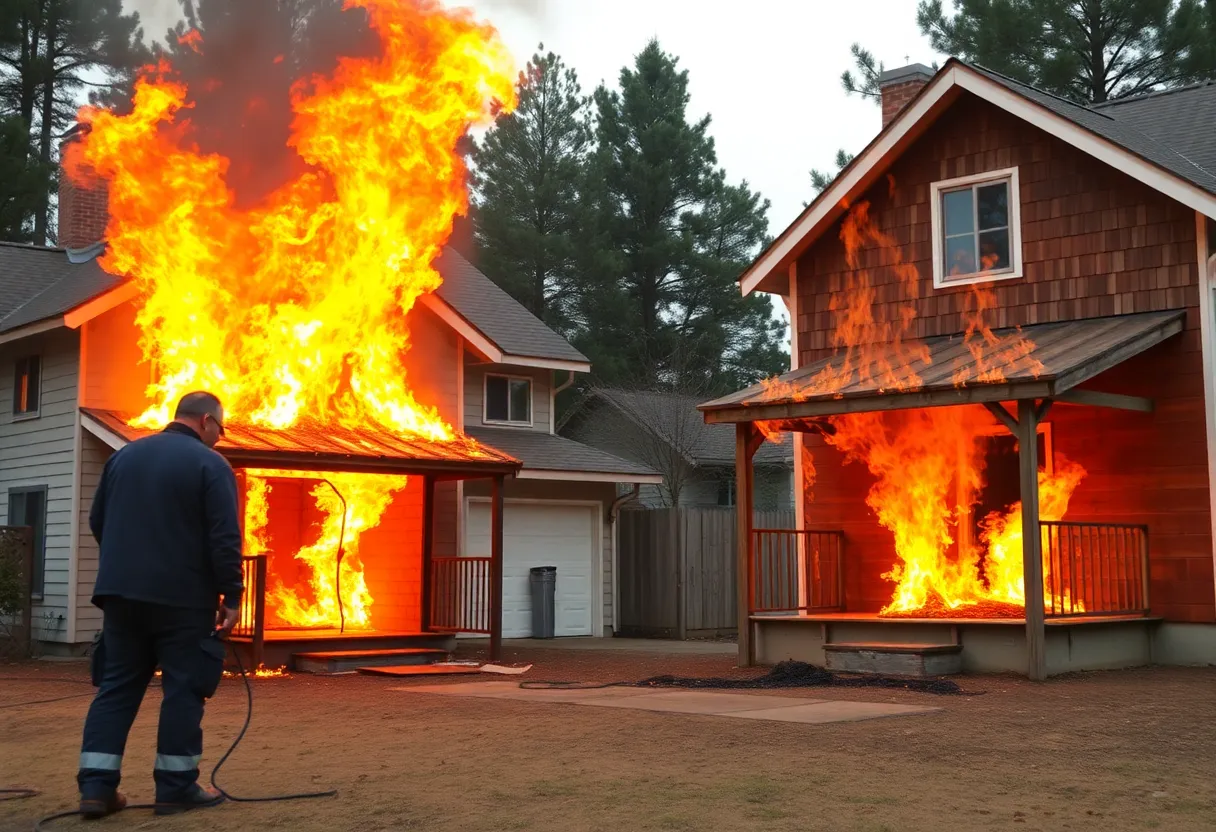News Summary
A fire-proofing demonstration in Anaheim, California showcased the dangers of outdated home construction in wildfire-prone areas. The event illustrated the effectiveness of modern fire mitigation features by comparing a standard home to one built with advanced materials. The demonstration highlighted the importance of Zone 0 and recommended retrofits for older homes to enhance safety against wildfires.
Fire-proofing Demonstration in Anaheim Highlights Risks of Outdated Home Construction Methods in Wildfire-Prone Areas
A fire-proofing demonstration was held on June 10 in Anaheim, California, organized to raise awareness about the dangers posed by outdated home construction in areas prone to wildfires. The event brought attention to the significant risks associated with older homes and showcased modern strategies for wildfire defense.
During the demonstration, two homes were intentionally set on fire under controlled conditions to illustrate the effectiveness of fire-mitigation features. One of the homes was built using standard construction materials and design, while the other was enhanced with advanced fire-resistance components.
The results of the test were striking. The unprotected home, which utilized common materials such as wood mulch, stacked firewood, and plastic gutters, ignited rapidly and collapsed within just 20 minutes. In contrast, the fire-protected house remained largely intact, showing only minimal damage to its exterior. This dramatic difference underscores the importance of implementing modern construction techniques in regions vulnerable to wildfires.
The demonstration aims to serve as a guiding example for rebuilding efforts in areas like Pacific Palisades and Altadena, which suffered extensive damage from wildfires in January 2025. The event emphasized the critical role of Zone 0, a five-foot perimeter around buildings that helps prevent embers from spreading and igniting homes. Effective management of this space can be essential for homeowners looking to enhance their fire safety.
Firefighters, simulating real-world wildfire conditions using industrial fans and drip torches, caused flames to quickly spread to the unprotected home. Within approximately 15 minutes, flames engulfed the interior of the unprotected structure. This alarming scenario highlights the necessity for homeowners to rethink safety measures.
The fire-resistant home was built with innovative features such as cement pavers, metal gutters, fiber cement siding, and enclosed eaves. Although the fire reached the perimeter, it was unable to spread beyond this protective barrier, demonstrating the effectiveness of modern materials in combating fire risks. The contrasting outcomes of the two homes serve as a compelling illustration of the critical difference that enhanced fire safety features can make.
It was noted that homes constructed prior to modern building codes pose a significant risk not only to themselves but also to their surrounding areas. Older homes often act as ignition sources during wildfires, potentially endangering neighboring properties. Homes equipped with fire-resistant features offer a protective buffer for nearby buildings, helping to reduce the overall impact of wildfires.
Quick retrofits, such as clearing vegetation in the Zone 0 area, were recommended as effective short-term strategies for homeowners. Many older properties, particularly in hillside locations, remain highly susceptible to wildfire threats. Recommending the replacement of combustible materials with non-flammable options, including cement, metal, and gravel, is essential for enhancing resilience against wildfires.
This demonstration is part of broader recovery efforts in California aimed at increasing public awareness regarding fire risks and the necessity of creating defensible spaces around properties. It advocates for updated design guidelines across fire-prone regions in the western United States to better protect homes and communities from devastating wildfires.
Previous fire events have shown that modern construction and design methodologies can significantly diminish fire damage in communities. Notably, the Orchard Hills community stands as a successful example, having avoided fire damage due to its fire-resistant design. This case reinforces the importance of adopting contemporary building practices to ensure safety against inevitable wildfire threats.
Deeper Dive: News & Info About This Topic
Construction CA Resources
Additional Resources
- Fire and Safety Journal Americas
- Los Angeles Times: House Burning Demonstration
- New York Times: Wildfires and Home Insurance
- Encyclopedia Britannica: Wildfires
- Google Search: Fire Resistant Construction
Author: Construction CA News
The CALIFORNIA STAFF WRITER represents the experienced team at constructioncanews.com, your go-to source for actionable local news and information in California and beyond. Specializing in "news you can use," we cover essential topics like product reviews for personal and business needs, local business directories, politics, real estate trends, neighborhood insights, and state news affecting the area—with deep expertise drawn from years of dedicated reporting and strong community input, including local press releases and business updates. We deliver top reporting on high-value events such as the Rose Parade, Coachella, Comic-Con, and the California State Fair. Our coverage extends to key organizations like the California Building Industry Association and Associated General Contractors of California, plus leading businesses in technology and entertainment that power the local economy such as Apple and Alphabet. As part of the broader network, including constructionnynews.com, constructiontxnews.com, and constructionflnews.com, we provide comprehensive, credible insights into the dynamic landscape across multiple states.




